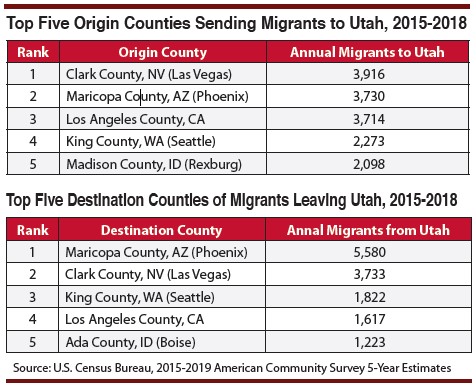Despite the common impression that most of Utah’s new residents are coming from California, an analysis by demographers at the Kem C. Gardner Policy Institute at the University of Utah found that other western states are contributing large numbers as well.
The study details how residents move in and out of each county in Utah, forming a pattern of migration flows unique to their region and time. Each of Utah’s 29 counties experience in-migration and out-migration, and a closer look at county-level patterns reveals geographic ties and trends unique to each{mprestriction ids="1,3"} county.
 “Our most recent analysis allows us to answer the most frequently asked questions about Utah’s migration patterns,” said Emily Harris, Gardner Institute senior demographer. “These include topics such as: ‘What counties are sending migrants to Utah? Which counties receive these out-of-state migrants? Are Utahns leaving the state? And if so, where are they going?’ The data confirm Utah has strong western migration ties to neighboring states, and that county migration patterns vary greatly from overall state migration patterns.”
“Our most recent analysis allows us to answer the most frequently asked questions about Utah’s migration patterns,” said Emily Harris, Gardner Institute senior demographer. “These include topics such as: ‘What counties are sending migrants to Utah? Which counties receive these out-of-state migrants? Are Utahns leaving the state? And if so, where are they going?’ The data confirm Utah has strong western migration ties to neighboring states, and that county migration patterns vary greatly from overall state migration patterns.”
The counties sending the most migrants to Utah and the number of people coming from those counties during the 2015 to 2019 study period are Clark County, Nevada (Las Vegas area), 3,916; Maricopa County, Arizona (Phoenix area), 3,730; Los Angeles County, California, 3,714; King County, Washington (Seattle area), 2,273; and Madison County, Idaho (Rexburg), 2,098.
According to the report, four Utah counties send and receive 75 percent of the migrants. They are Salt Lake, Utah, Davis and Washington counties.
The study also found that for every resident leaving the state — about 3 percent of the population annually — another resident moves to a different county within the state. Eighteen Utah counties lost more residents to in-state migration than they gained, led by Salt Lake, Summit and Uintah counties. While Utah County gained most of its in-migrants from other states, Tooele County’s migrants overwhelmingly relocated from other counties within Utah.
The full report is available on the Gardner Institute website at gardner.utah.edu.{/mprestriction}







